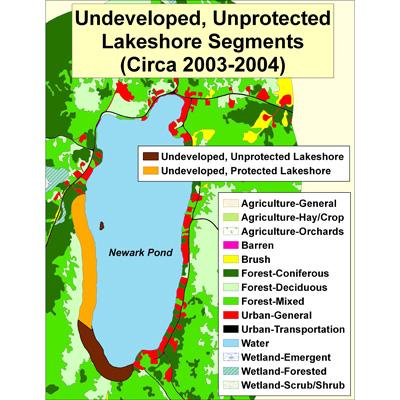Lakeshore Development Patterns in the Northern Forest of Vermont and Implications for Water Quality

Lakeshores in the Northern Forest of Vermont are sensitive ecological zones that provide essential habitat for many terrestrial and aquatic species and protect water quality by preventing erosion and filtering nutrients. Aesthetic qualities of lakeshores also make them attractive locations for second homes and camps. To protect Vermont’s remaining undeveloped lakeshores, it is necessary to quantify the current extent of development around lakes, demonstrate a relationship between landscape patterns and water quality, and examine near-shore habitat characteristics that are affected by shoreline changes.
NSRC researchers conducted a lakeshore assessment at two scales: 1) near-shore habitat at specific sites; and 2) landscapes encompassing entire lakes. First, they digitized land-use/land-cover patterns for 74 lakes in northeastern Vermont, creating maps within a 600-meter buffer for each lake. Researchers then collected near-shore habitat data for 28 of the lakes, including shade cover, woody debris, sediments, and aquatic vegetation. Finally, they used landscape characteristics from the maps, near-shore habitat data, and existing water quality data to develop statistical models linking development patterns to environmental quality indices.
Lakeshore segments that are both undeveloped and unprotected were identified by comparing the maps to conserved lands data. Statistical models indicated that landscape slope, level of urban development, quantities of undeveloped shorelines, and lake shape, depth, and flushing rate contribute to quality of available habitat and lake health. Findings showed that lakeshore development adversely affects water quality and aquatic habitat. These results support lake monitoring and conservation planning efforts and assist regulatory and outreach efforts by illustrating the ecological value of conserving stretches of undeveloped lake shorelines.
Download printable version [PDF]
Download full final report [PDF]
